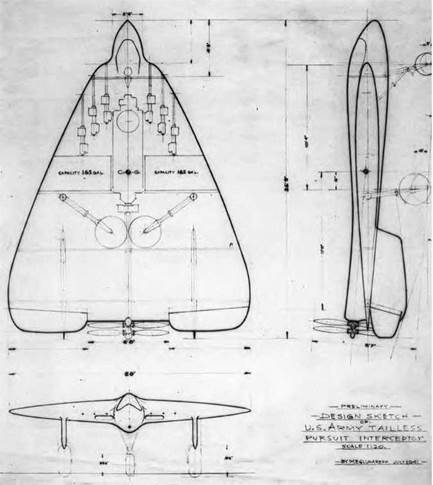The Gluhareff-Griswold Nexus
In 1936, Michael E. Gluhareff, an emigree Russian engineer who was chief of design for the Vought-Sikorsky Aircraft Division of United
Aircraft Corporation, began examining various tailless aircraft configurations. By July 1941, his study had spawned a proposed interceptor fighter powered by a piston engine driving a contra-rotating pusher propeller. It had a rounded delta planform resembling an arrowhead, with leading edges swept aft at 56 degrees. It featured a tricycle retractable landing gear, twin ventral vertical fins, an extremely streamlined and rounded configuration, provisions for six heavy machine guns, and elevons (combined ailerons and elevators) for roll and pitch control. Gluhareff informed company founder Igor I. Sikorsky that its sharp sweep would delay the onset of transonic compressibility, noting, "The general shape and form of the aircraft is, therefore, outstandingly adaptable for extremely high speeds.”[12]
![]() In retrospect, Gluhareff’s design was a remarkable achievement, conceived at just the right time to have been completed with turbojet propulsion (for which its configuration and internal layout was eminently suited) though circumstances conspired against its development. Sikorsky was then perfecting the first practical helicopter—the VS-300, another revolutionary development, of course—and chose understandably to concentrate on rotary wing flight. He did authorize Gluhareff to solicit support from inventor-entrepreneur Roger W. Griswold, president of the Ludington-Griswold Company, about building a wind tunnel model of the configuration.[13] Tests by United Aircraft proved so encouraging that Griswold approached the engineering staff of the Army Air Forces (AAF) at its Wright Field Aircraft Laboratory about sponsoring what was now called the "Dart.”[14] But having their fill of visitors
In retrospect, Gluhareff’s design was a remarkable achievement, conceived at just the right time to have been completed with turbojet propulsion (for which its configuration and internal layout was eminently suited) though circumstances conspired against its development. Sikorsky was then perfecting the first practical helicopter—the VS-300, another revolutionary development, of course—and chose understandably to concentrate on rotary wing flight. He did authorize Gluhareff to solicit support from inventor-entrepreneur Roger W. Griswold, president of the Ludington-Griswold Company, about building a wind tunnel model of the configuration.[13] Tests by United Aircraft proved so encouraging that Griswold approached the engineering staff of the Army Air Forces (AAF) at its Wright Field Aircraft Laboratory about sponsoring what was now called the "Dart.”[14] But having their fill of visitors
|
The proposed Gluhareff Dart fighter of 1941, showing both its novel layout and, for the time, nearly as novel tricycle landing gear layout. National Air and Space Museum, Smithsonian Institution. |
bringing a series of the weird and unconventional, and charged with ensuring that the AAF acquired large numbers of aircraft, and quickly, the AAF’s engineers did not pursue the project.[15]
So the Gluhareff-Griswold Dart never reached the hardware stage, the failure to build it counting as a loss to American midcentury aeronautics. As for Gluhareff, though he had made notable contributions to Sikorsky’s large flying boats (and would, as well, to his helicopters), he continued
to explore the basic design of his intriguing if abortive configuration, proposing a variety of derivatives, including in 1959 a Mach 2+ supersonic transport with a small canard wing and double-deck fuselage.[16] If the Dart never saw development, its configuration nevertheless proved significant. In 1944, Griswold resurrected the Dart shape for a proposed 2,000-pound guided glide bomb, or "glomb.” The Army Air Forces recommended he obtain the NACA’s opinion of its aerodynamics, and for this, Griswold turned to Langley Memorial Aeronautical Laboratory. There, on August 19, he met with the NACA’s resident aerodynamic expert on "pilotless missiles,” Robert T. Jones. Out of that contact would emerge both the American delta and swept wing.











